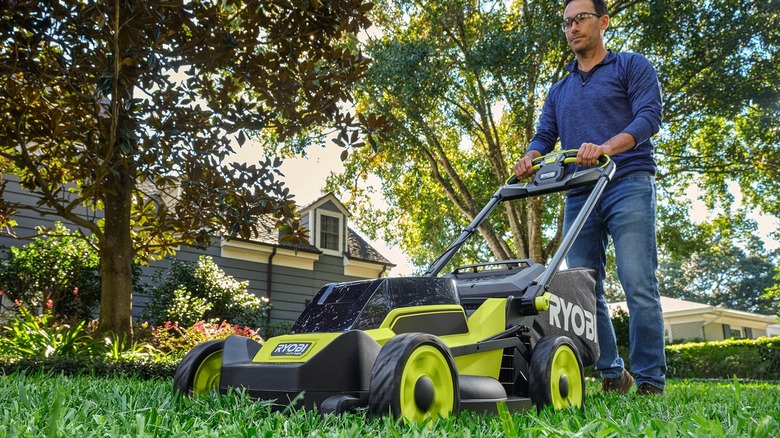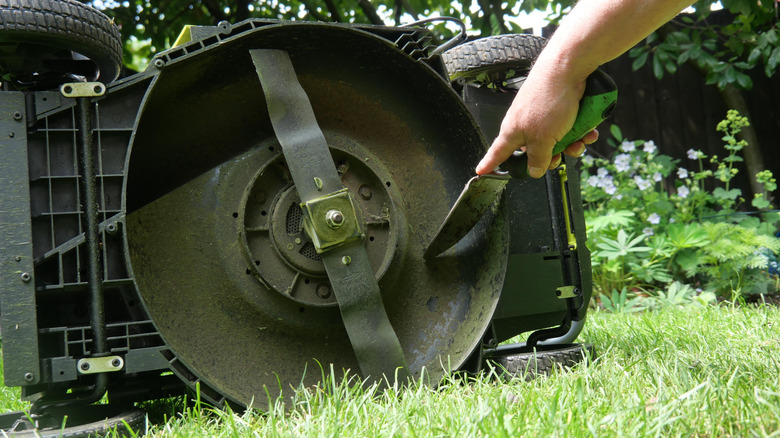What's The Battery Life On Ryobi's Electric Walk Behind Push Mower?
In the world of battery-powered lawn mowers, Ryobi Tools is a brand that's trusted by many homeowners. It sells a variety of electric walk-behind push mowers designed to make turf maintenance less labor-intensive and more enjoyable. Battery life — both on a per-use basis and long term — is a key consideration you'll want to keep in mind when selecting which mower is right for you. These vary by model and voltage. For example, the Ryobi 18V One+ 13” Push Mower Kit has a 30-minute runtime per charge, while higher-voltage models like the Ryobi 40V HP Brushless 21” Push Mower Kit, have batteries that can power the mower for up to 55 minutes (albeit for a steeper price tag). However, the runtime and long-term battery life are also subject to how you use your mower and how well you care for it.
Choosing a model that stays charged for longer means you'll probably get the most bang for your buck. Ultimately, though, what's suitable for you will depend on how big the area you're trying to mow is — whether you can adequately cover its entire surface area with a single charge, and how much cleaning or maintenance you're willing to do to keep your mower's battery running smoothly.
Factors that can affect your Ryobi push mower's battery life
Even if you opt for a Ryobi model with a longer suggested runtime, a number of factors can impact it in practice. Many are common knowledge. For instance, if you're frequently starting and stopping your mower or cutting thick, dense grass, its per-use battery life won't stretch as long. Extreme hot or cold temperatures can dock it too. And if you're not cleaning your mower from top to bottom regularly, it will have to exert more battery power to do its job. That can also shorten the battery life per use.
Another thing to keep in mind is that batteries naturally age and become less effective with repeated charges. In other words, your mower battery's ability to hold a charge for the full duration of its purported runtime will wane over the years. Battery University estimates that the average long-term battery life for a lithium-ion battery in most consumer products, such as Ryobi push mowers, is between 300 and 500 discharge and charge cycles. So, let's say you're mowing your lawn twice a week for half the calendar year, and a single charge is enough to cover the whole thing. In a perfect world — and using the conservative end of that estimate — you could get more than five years' worth of discharge and charge cycles before you have to replace the battery. But, again, that calculation isn't conclusive.
Tips for prolonging the battery life and replacing it
No matter what model you have, there are proactive steps you can take to prolong your Ryobi push mower's battery life. Again, many of these tips are common sense. First things first: Clean the mower regularly, including the battery terminal! Avoid overcharging, which can actually harm lithium-ion batteries over time. Likewise, run the mower for longer stretches of time (no repeated stopping and starting). Minimize your mower's exposure to extreme hot or cold weather, and if you don't plan to use it for a long period of time, store it somewhere temperate and dry so it stays damage-free.
If your lawn mower won't start or the battery isn't holding a charge like it used to, you may need to replace it. First, check the warranty — many of the brand's models are backed by them. Ryobi sells replacements in its online parts store, too, although they can get pricey. (You can also safely recycle the old battery at your local Home Depot.) Before you buy, double check the voltage and make sure it aligns with your model. For tailored guidance, visit Ryobi's website to connect with its customer support team.


